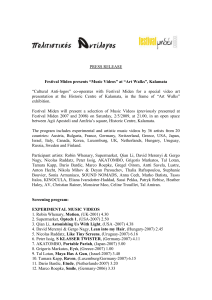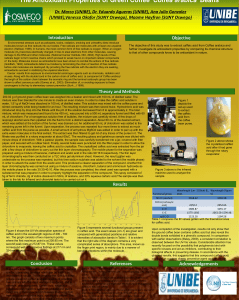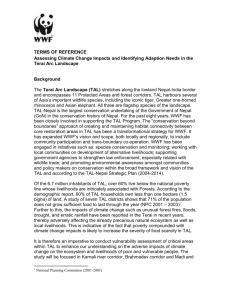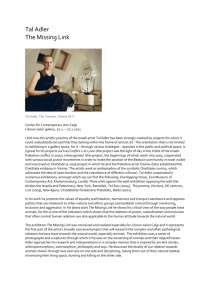Heterologous production of caffeic acid from tyrosine in Escherichia coli Please share
advertisement
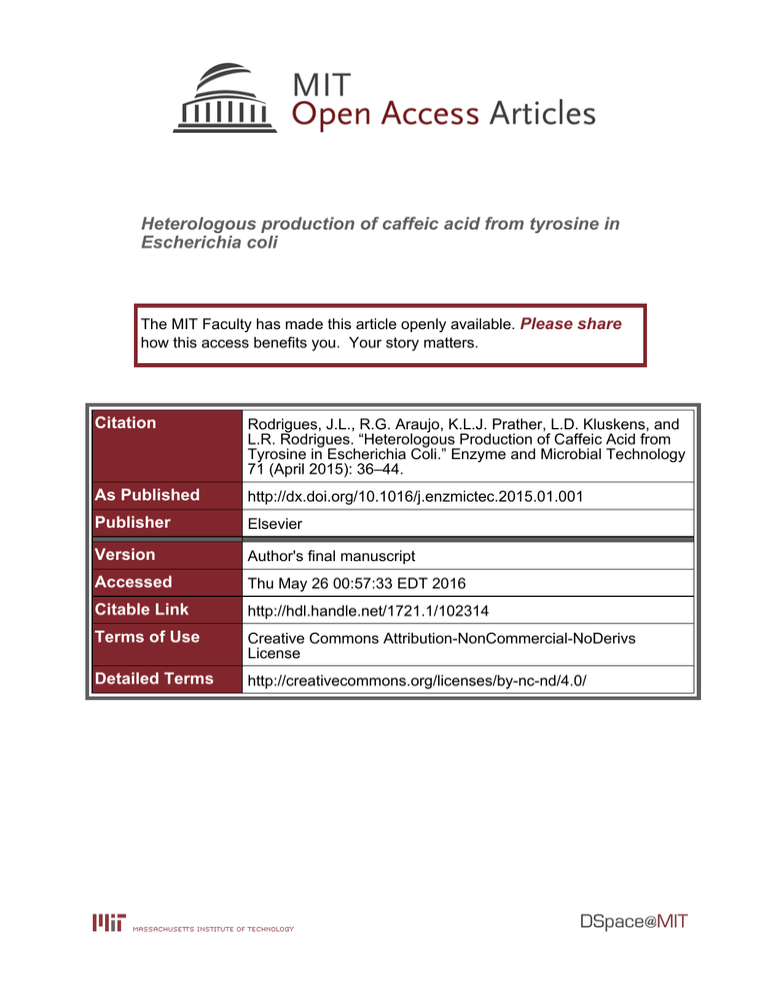
Heterologous production of caffeic acid from tyrosine in Escherichia coli The MIT Faculty has made this article openly available. Please share how this access benefits you. Your story matters. Citation Rodrigues, J.L., R.G. Araujo, K.L.J. Prather, L.D. Kluskens, and L.R. Rodrigues. “Heterologous Production of Caffeic Acid from Tyrosine in Escherichia Coli.” Enzyme and Microbial Technology 71 (April 2015): 36–44. As Published http://dx.doi.org/10.1016/j.enzmictec.2015.01.001 Publisher Elsevier Version Author's final manuscript Accessed Thu May 26 00:57:33 EDT 2016 Citable Link http://hdl.handle.net/1721.1/102314 Terms of Use Creative Commons Attribution-NonCommercial-NoDerivs License Detailed Terms http://creativecommons.org/licenses/by-nc-nd/4.0/ Accepted Manuscript Title: Heterologous production of caffeic acid from tyrosine in Escherichia coli Author: J.L. Rodrigues R.G. Araújo K.L.J. Prather L.D. Kluskens L.R. Rodrigues PII: DOI: Reference: S0141-0229(15)00002-2 http://dx.doi.org/doi:10.1016/j.enzmictec.2015.01.001 EMT 8718 To appear in: Enzyme and Microbial Technology Received date: Revised date: Accepted date: 16-10-2014 30-12-2014 6-1-2015 Please cite this article as: Rodrigues JL, Araújo RG, Prather KLJ, Kluskens LD, Rodrigues LR, Heterologous production of caffeic acid from tyrosine in Escherichia coli, Enzyme and Microbial Technology (2015), http://dx.doi.org/10.1016/j.enzmictec.2015.01.001 This is a PDF file of an unedited manuscript that has been accepted for publication. As a service to our customers we are providing this early version of the manuscript. The manuscript will undergo copyediting, typesetting, and review of the resulting proof before it is published in its final form. Please note that during the production process errors may be discovered which could affect the content, and all legal disclaimers that apply to the journal pertain. 1 2 ip t O OH NH2 HO L-tyrosine O OH C3H OH caffeic acid te d M an us p-coumaric acid HO Ac ce p HO O CYP199A2 HO or cr TAL 1 Page 1 of 37 2 Highlights 3 Escherichia coli was engineered for the production of caffeic acid. 5 Tyrosine ammonia lyase (TAL) converted 3 mM of tyrosine to 2.62 mM p-coumaric 11 12 13 cr us an 10 This is the first study that shows caffeic acid production using TAL and CYP199A2. M 9 acid. TAL and CYP199A2 converted tyrosine in 1.56 mM caffeic acid. d 8 TAL and 4-coumarate 3-hydroxylase (C3H) converted tyrosine in 1 mM caffeic te 7 acid. Ac ce p 6 ip t 4 2 Page 2 of 37 13 Heterologous production of caffeic acid from tyrosine in Escherichia coli 14 J. L. Rodriguesa,c, R. G. Araújoa, K. L. J. Pratherb,c, L.D. Kluskensa, L.R. Rodriguesa,c* 15 ip t 16 17 a 18 b 19 (SynBERC) Massachusetts Institute of Technology, Cambridge, MA 02139, USA 20 c Centre of Biological Engineering, University of Minho, 4710 - 057 Braga, Portugal us cr Department of Chemical Engineering, Synthetic Biology Engineering Research Center MIT-Portugal Program, Cambridge, MA and Lisbon, Portugal 37 M d * te 27 28 29 30 31 32 33 34 35 36 J. L. Rodrigues – joana.joanalucia@deb.uminho.pt R. G. Araújo - rafa.gomes.ar@gmail.com K. L. J. Prather - kljp@mit.edu L.D. Kluskens – kluskens@deb.uminho.pt L.R. Rodrigues - lrmr@deb.uminho.pt Corresponding author: Lígia R. Rodrigues Address: Centre of Biological Engineering, University of Minho, 4710 - 057 Braga, Portugal Tel: (+351) 253 604 401 Fax: (+351) 253 604 429 E-mail address: lrmr@deb.uminho.pt Ac ce p 22 23 24 25 26 an 21 38 39 40 41 3 Page 3 of 37 Abstract 43 Caffeic acid is a plant secondary metabolite and its biological synthesis has attracted 44 increased attention due to its beneficial effects on human health. In this study, Escherichia 45 coli was engineered for the production of caffeic acid using tyrosine as the initial precursor 46 of the pathway. The pathway design included tyrosine ammonia lyase (TAL) from 47 Rhodotorula glutinis to convert tyrosine to p-coumaric acid and 4-coumarate 3-hydroxylase 48 (C3H) from Saccharothrix espanaensis or cytochrome P450 CYP199A2 from 49 Rhodopseudomonas palustris to convert p-coumaric acid to caffeic acid. The genes were 50 codon-optimized and different combinations of plasmids were used to improve the titer of 51 caffeic acid. TAL was able to efficiently convert 3 mM of tyrosine to p-coumaric acid with 52 the highest production obtained being 2.62 mM (472 mg/L). CYP199A2 exhibited higher 53 catalytic activity towards p-coumaric acid than C3H. The highest caffeic acid production 54 obtained using TAL and CYP199A2 and TAL and C3H was 1.56 mM (280 mg/L) and 1 55 mM (180 mg/L), respectively. This is the first study that shows caffeic acid production 56 using CYP199A2 and tyrosine as the initial precursor. This study suggests the possibility of 57 further producing more complex plant secondary metabolites like flavonoids and 58 curcuminoids. 60 cr us an M d te Ac ce p 59 ip t 42 Keywords: tyrosine; p-coumaric acid; caffeic acid; E. coli; biosynthesis; synthetic biology 61 62 63 4 Page 4 of 37 1. Introduction 65 Caffeic acid is a natural phenolic compound derived from the phenylpropanoid pathway in 66 plants. Phenylpropanoic acids, especially caffeic acid, have attracted an increased attention 67 owing to their valuable properties, including antioxidant [1], anti-inflammatory [2], 68 anticancer [3], antiviral [4], antidiabetic [5] and antidepressive [6]. Due to its 69 pharmaceutical applications there is an established market for caffeic acid production. 70 Caffeic acid is mainly obtained by extraction from plants and these extraction methods 71 include high temperatures, treatment with petroleum and solvent extraction (methanol, 72 ethyl acetate), thus being energy-intensive and environmentally unfriendly [7]. Moreover, 73 the yields obtained are low because it accumulates at low levels in plant cells. To meet the 74 phenylpropanoids market needs, it is imperative to look for new green and environmental 75 production methods to replace the traditional extraction one. One way to achieve high 76 levels of caffeic acid is the production via engineered microorganisms, such as Escherichia 77 coli [8-10]. 78 Natural caffeic acid production starts with the deamination of the amino acid phenylalanine 79 which is converted to cinnamic acid by phenylalanine ammonia lyase (PAL) (Fig. 1). Then, 80 cinnamic acid is converted in to p-coumaric acid by cinnamate-4-hydroxylase (C4H), and 81 caffeic acid is obtained from p-coumaric acid using 4-coumarate 3-hydroxylase (C3H). 82 Tyrosine can also be used as a precursor as some PALs also have tyrosine ammonia lyase 83 (TAL) activity [11, 12]. Since tyrosine already possesses a 4-hydroxyl group, its use is 84 advantageous as it can be directly converted to p-coumaric acid, thus decreasing the 85 number of steps to produce caffeic acid. Also, using TAL, the C4H enzyme that is essential Ac ce p te d M an us cr ip t 64 5 Page 5 of 37 for caffeic acid production in plants and has not yet been successfully expressed in 87 prokaryotic organisms [13] is not needed anymore. 88 In the last decade several efforts have been conducted to produce caffeic acid using 89 microorganisms. Berner et al. [14] identified sam8 and sam5 genes, encoding TAL and 90 C3H involved in caffeic acid biosynthesis in the actinomycete Saccharothrix espanaensis 91 and expressed them in Streptomyces fradiae XKS. After that, these enzymes were used to 92 produce caffeic acid in E. coli (Table 1). Other bacterial TAL (Rhodobacter capsulatus and 93 Rhodotorula glutinis) were also used for the production of p-coumaric acid and 94 hydroxyphenylacetate 3-hydroxylase (4HPA3H) from E. coli or Pseudomonas aeruginosa, 95 and cytochrome P450 CYP199A2 from Rhodopseudomonas palustris was proved to 96 convert p-coumaric acid to in caffeic acid with a high yield. 97 In this study, we describe the production of caffeic acid from tyrosine or p-coumaric acid. 98 To convert tyrosine to in p-coumaric acid we used TAL from R. glutinis. p-coumaric acid 99 was converted to in caffeic acid using C3H from S. espanaensis or CYP199A2 from R. Ac ce p te d M an us cr ip t 86 100 palustris. Although all these genes have previously been used in the caffeic acid 101 production, it is important to mention that, as far as we know, the caffeic acid production 102 from tyrosine using CYP199A2 in the pathway has never been attempted. Additionally, in 103 the current study, the titers of caffeic acid obtained using TAL and C3H genes were higher 104 than the ones reported in other studies using the same genes. These high yields were 105 obtained by using different combinations of plasmids and genetic arrangements. 6 Page 6 of 37 Furthermore, it is important to mention that the caffeic acid pathway can be further used to 107 produce other products of the phenylpropanoid pathway with high added-value like 108 flavonoids and curcuminoids. Ac ce p te d M an us cr ip t 106 7 Page 7 of 37 ip t cr TAL and opTAL - S. espanaensis C3H - S. espanaensis ΔtyrR; tyrAfbr- aroGfbr 4HPA3H - P. aeruginosa a (not mentioned) Choi et al. [15] 50.2 (TYR strain) 12.1 (wild-type) Lin and Yan [16] First induction in LB at 37 ºC. After 5 h cells were harvested and transferred to M9 medium (glucose) at 26 ºC for 36 h in shake flasks 150 (TAL, TYR strain) 40 (opTAL, TYR strain) 42 (TAL, wild-type) 14 (opTAL, wild-type) Kang et al. [17] Potassium phosphate buffer (glucose or glycerol) at 30 ºC in shake flasks for 24 h. 20 mM p-coumaric acid was added. 510 (wild-type) 2800 (mutant) Furuya et al. [8] 88 (LB, glucose, test tube) 106 (bioreactor) Zhang and Stephanopoulos [18]c 3820 (wild-type) 766.68 (TYR strain) Huang et al. [10] 10200 Furuya and Kino [9] M9 medium (glucose and glycerol) at 37 ºC. After induction shake flasks were transferred to 30 ºC for 48 h MOPS medium (glucose or xylose), synthetic medium (glucose or xylose) or LB (glucose or xylose) at 37 ºC for 72 h in test tubes; S Synthetic medium (glucose) at 37 ºC for 7 days in bioreactor M9 medium (yeast extract and glycerol, or glucose and glycerol) at 37 ºC for 72 h in shake flasks. 20 mM p-coumaric acid fed 3 h after induction and 3 mM added afterward (wild-type case) Potassium phosphate buffer (glucose or glycerol) at 30 ºC for 24 h in shake flasks. 20 mM of p-coumaric acid was added 4 3 times In some studies a tyrosine overproducing strain was used in which: tyrR (tyrosine repressor) and pheA (chorismate mutase / prephenate dehydratase) were deleted (ΔtyrR and ΔpheA) to direct the pathway only to tyrosine production; ppsA (PEP synthase) and tktA (transkelotase) were overexpressed to increase the availability of the two main precursors of aromatic amino acids biosynthesis; and tyrA (chorismate mutase / prephenate dehydrogenase) and aroG (3-deoxy-D-arabino-heptulosonate 7-phosphate synthase) gene sequences were modified and the feedback inhibition-resistant derivatives (tyrAfbr and aroGfbr) were overexpressed to remove the transcriptional control mediated by tyrosine and phenylalanine. OpTAL means codon-optimized TAL. bTYR strain – tyrosine overproducing strain; cAn alternative route through coumaroyl-CoA and caffeoyl-CoA (Fig. 1) using 4CL from P. crispus and E. coli endogenous thiosterase was tested to increase the yield but it was not successful. Ac 110 111 112 113 114 115 Reference ce pt CYP199A2 (wild-type and mutant F185L) - R. palustris Pdr - Pseudomonas putida Pux - R. palustris TAL - R. glutinis C3H - S. espanaensis ΔpheA ΔtyrR; tyrAfbr-aroGfbr TAL - R. glutinis 4HPA3H - E. coli ΔpheA; tyrAfbr-ppsA-tktA-aroGfbr Titer (mg/L)b Fermentation Conditions First induction in LB at 37 ºC. After 5 h cells were transferred to M9 medium (glucose) at 26 ºC for 36 h M an Genes – Organismsa TAL - S. espanaensis C3H - S. espanaensis TAL - R. capsulatus 4HPA3H - E. coli ΔtyrR; tyrAfbr-ppsA-tktA-aroGfbr us Table 1. Caffeic acid production in Escherichia coli. Genes/organisms used in the caffeic acid biosynthetic pathway, fermentation conditions and yields. ed 109 8 Page 8 of 37 2. Materials and Methods 117 2.1 Bacterial strains, plasmids and chemicals 118 E. coli ElectroMAXTM DH10B competent cells (Invitrogen/Life Technologies, Carlsbad, 119 CA, USA) were used for molecular cloning and vector propagation. E. coli K-12 120 MG1655(DE3) [19] was used as the host for the expression of genes under the control of 121 the T7 promoter. 122 P. putida JCM 6157 strain (ATCC 17453, Manassas, VA, USA) and R. palustris CGA009 123 gDNA (ATCC BAA-98) were used to amplify the pdr and pux genes. The characteristics of 124 all the strains and plasmids used in this study are described in Table 2. 125 Restriction, ligation and Q5 enzymes (NEB, Ipswich, MA, USA), QIAprep Spin Miniprep 126 Kit (Qiagen, Germantown, MD, USA), DNA Clean and Concentrator and Gel DNA 127 Recovery Kits (Zymo Research, Orange, CA, USA) and Wizard® Genomic DNA 128 Purification Kit (Promega, Madison, WI, USA) were used according to the instructions 129 provided by the manufacturers. 130 L-Tyrosine, 131 (Steinheim, Germany), isopropyl β-D-thiogalactopyranoside (IPTG) and Luria-Bertani 132 (LB) medium from NZYTech (Lisbon, Portugal) and anhydrotetracycline (aTc) from Acros 133 (Geel, Belgium). Glucose (Acros), Na2HPO4 (Scharlau, Sentmenat, Spain), MgSO4, 134 KH2PO4 (Riel-deHaën, Seelze, Germany), NH4Cl, NaCl, CaCO3 (Panreac, Barcelona, 135 Spain) and thiamine (Fisher Scientific, Loughborough, UK) were used to prepare the M9 136 modified salt medium. The following mineral traces and vitamins were supplemented to the 137 M9 medium: FeCl3, ZnCl2, CoCl2, CuCl2, nicotinic acid (Riedel-deHaën), NaMoO4, 138 H2BO3, pyridoxine, biotin, folic acid (Merck), riboflavin and pantothenic acid (Sigma te d M an us cr ip t 116 Ac ce p p-coumaric acid and caffeic acid were purchased from Sigma-Aldrich 9 Page 9 of 37 139 Aldrich). Ampicillin (Applichem, Darmstadt, Germany), chloramphenicol, kanamycin 140 (NZYtech) and spectinomycin (Panreac) were used when necessary. Table 2. Bacterial strains and plasmids used in this study Strains Relevant Genotype F- mcrA ∆(mrr-hsdRMS-mcrBC) φ80lacZ∆M15 ∆lacX74 recA1 endA1 araD139 ∆(ara, leu)7697 galU galK λ- rpsL nupG F- λ- ilvG- rfb-50 rph-1 λ(DE3) us E. coli K-12 MG1655(DE3) P. putida JCM 6157 M pUC57_TAL pUC57_C3H te d pUC57_CYP199A2 pETDuet_C3H Construct ColE1(pBR322) ori, lacI, double T7lac, AmpR CloDF13 ori, lacI, double T7lac, StrepR RSF ori, lacI, double T7lac, KanR p15A ori, tetR, Ptet, AmpR pUC57 carrying codon-optimized TAL from R. glutinis pUC57 carrying codon-optimized C3H from S. espanaensis pUC57 carrying codon-optimized CYP199A2 from R. palustris pETDuet-1 carrying codon-optimized TAL from R. glutinis pETDuet-1 carrying codon-optimized C3H from S. espanaensis pETDuet_TAL carrying codon-optimized C3H from S. espanaensis pCDFDuet-1 carrying codon-optimized TAL from R. glutinis pCDFDuet-1 carrying codon-optimized C3H from S. espanaensis pCDFDuet-1 carrying codon-optimized CYP199A2 from R. palustris pCDFDuet-1 carrying codon-optimized CYP199A2 from R. palustris with the first 7 amino acids pCDFDuet_TAL carrying codon-optimized CYP199A2 from R. palustris pCDFDuet_TAL carrying CYP199A2 from R. palustris with the first 7 amino acids pCDFDuet-1 carrying codon-optimized TAL from R. glutinis and CYP199A2 from R. palustris in an operon pCDFDuet-1 carrying codon-optimized TAL from R. glutinis and CYP199A2 from R. palustris with the first 7 amino acids in an operon pKVS45 carrying codon-optimized TAL from R. an Genomic DNA R. palustris CGA009 Plasmids pETDuet-1 pCDFDuet-1 pRSFDuet-1 pKVS45 pETDuet_TAL pETDuet_TAL_C3H pCDFDuet_TAL pCDFDuet_C3H pCDFDuet_CYP pCDFDuet_CYP (+7aa) pCDFDuet_TAL_CYP pCDFDuet_TAL_CYP (+7aa) pCDFDuet_TAL_CYP_op pCDFDuet_TAL_CYP(+7aa)_op pKVS45_TAL Source Invitrogen/Life Technologies cr E. coli Electromax DH10B Ac ce p 142 ip t 141 [19] ATCC 17453 Source ATCC BAA-98D-5 Source Novagen Novagen Novagen [20] GenScript GenScript GenScript This study This study This study This study This study This study This study This study This study This study This study This study 10 Page 10 of 37 pRSFDuet_TAL pRSFDuet_C3H pKVS45_Pdr_Pux_op pETDuet_Pdr_Pux_op This study This study This study This study ip t pKVS45_C3H glutinis pKVS45 carrying codon-optimized C3H from S. espanaensis pRSFDuet-1 carrying codon-optimized TAL from R. glutinis pRSFDue-1t carrying codon-optimized C3H from S. espanaensis pKVS45 carrying Pdr from P. putida and Pux from R. palustris in an operon pETDuet-1 carrying Pdr from P. putida and Pux from R. palustris in an operon cr 143 This study 144 2.2 Codon-optimization and synthesis of TAL, C3H and CYP199A2 146 TAL, C3H and CYP199A2 genes were codon-optimized for E. coli, synthesized and cloned 147 in pUC57 vector by GenScript (Piscataway, NJ, USA). In addition to codon-optimization, 148 the phenylalanine residue at 185 position (F185) of CYP199A2 was replaced by leucine 149 (F185L)[8]. The DNA sequences of the codon-optimized genes are provided in Table 3. 150 Supplementary Material (Table S1). 153 154 155 an M d te 152 Ac ce p 151 us 145 156 157 11 Page 11 of 37 ip t cr Table 3. Gene sequences of TAL, C3H and CYP199A2 with codon optimization. Sequence ATGGCTCCGCGTCCGACCTCGCAATCCCAAGCTCGCACCTGCCCGACCACCCAAGTTACCCAAGTTGACATCGTTGAAAAAA TGCTGGCGGCGCCGACCGATTCGACGCTGGAACTGGACGGCTATAGCCTGAACCTGGGTGATGTGGTTTCTGCAGCACGTAA AGGTCGTCCGGTGCGTGTTAAAGATTCAGACGAAATTCGCTCGAAAATCGATAAAAGCGTGGAATTTCTGCGTAGCCAGCTG AGCATGTCTGTTTACGGCGTCACCACGGGTTTCGGCGGTTCAGCCGATACCCGCACGGAAGACGCCATTTCGCTGCAGAAAG CACTGCTGGAACATCAACTGTGCGGCGTGCTGCCGAGCTCTTTTGATAGCTTCCGCCTGGGCCGTGGTCTGGAAAACTCTCTG CCGCTGGAAGTCGTGCGTGGTGCAATGACCATCCGTGTTAATTCCCTGACGCGCGGTCATTCAGCTGTCCGTCTGGTTGTCCT GGAAGCGCTGACCAACTTTCTGAATCACGGTATTACGCCGATCGTGCCGCTGCGTGGTACCATTAGTGCATCCGGTGATCTG AGCCCGCTGTCTTATATTGCAGCTGCGATCTCTGGCCACCCGGACAGTAAAGTTCATGTGGTTCACGAGGGTAAAGAAAAAA TCCTGTACGCCCGTGAAGCTATGGCGCTGTTCAACCTGGAACCGGTCGTGCTGGGCCCGAAAGAAGGCCTGGGTCTGGTGAA TGGTACGGCTGTTTCAGCGTCGATGGCCACCCTGGCACTGCATGATGCCCACATGCTGAGCCTGCTGAGCCAGTCTCTGACC GCGATGACGGTCGAAGCGATGGTGGGCCATGCAGGTAGCTTTCATCCGTTCCTGCACGATGTGACCCGTCCGCACCCGACGC AGATTGAAGTTGCAGGCAACATCCGCAAACTGCTGGAAGGTAGCCGTTTTGCGGTGCATCACGAAGAAGAAGTGAAAGTGA AAGATGACGAAGGCATTCTGCGCCAGGATCGTTATCCGCTGCGTACCAGTCCGCAATGGCTGGGTCCGCTGGTCTCCGACCT GATTCATGCCCACGCAGTGCTGACCATCGAAGCGGGTCAGAGTACCACGGATAACCCGCTGATTGACGTGGAAAATAAAAC CTCTCATCACGGCGGTAACTTTCAAGCCGCAGCTGTTGCCAATACGATGGAAAAAACGCGCCTGGGCCTGGCACAGATCGGT AAACTGAATTTCACCCAACTGACGGAAATGCTGAACGCAGGCATGAATCGTGGTCTGCCGAGCTGCCTGGCAGCAGAAGAT CCGAGTCTGTCCTATCATTGTAAAGGCCTGGACATTGCAGCTGCGGCCTACACCTCTGAACTGGGTCATCTGGCGAACCCGG TTACCACGCACGTCCAGCCGGCTGAAATGGCGAACCAAGCCGTGAATTCCCTGGCACTGATCTCAGCTCGTCGCACCACGGA ATCGAATGATGTCCTGAGCCTGCTGCTGGCGACCCATCTGTATTGTGTTCTGCAGGCTATTGACCTGCGCGCGATCGAATTTG AATTCAAAAAACAGTTTGGCCCGGCTATTGTGAGCCTGATCGATCAACACTTCGGCTCTGCCATGACCGGTAGTAACCTGCG TGACGAACTGGTGGAAAAAGTTAATAAAACGCTGGCCAAACGCCTGGAACAGACCAACAGTTACGATCTGGTGCCGCGTTG GCATGACGCATTTTCCTTCGCAGCTGGTACGGTTGTCGAAGTTCTGAGTTCCACCTCACTGTCGCTGGCGGCCGTCAATGCCT GGAAAGTGGCAGCTGCGGAAAGTGCAATTTCCCTGACCCGCCAAGTGCGTGAAACGTTTTGGTCAGCAGCATCGACGTCATC GCCGGCACTGAGCTATCTGTCTCCGCGCACCCAAATTCTGTACGCTTTTGTTCGTGAAGAACTGGGCGTCAAAGCGCGTCGC GGCGATGTTTTCCTGGGTAAACAGGAAGTGACCATCGGTAGTAATGTTTCCAAAATCTATGAAGCTATCAAAAGCGGTCGTA TCAATAATGTGCTGCTGAAAATGCTGGCATAA 159 Ac ce pt TAL (Rhodotorula glutinis) ed M an Gene us 158 160 161 12 Page 12 of 37 ip t cr Table 3. Gene sequences of TAL, C3H and CYP199A2 with codon optimization (continuation). CYP199A2 (Rhodopseudom onas palustris) Ac ce pt ed C3H (Saccharothrix espanaensis) Sequence ATGACGATTACCTCTCCGGCACCGGCTGGTCGCCTGAACAATGTCCGCCCGATGACGGGTGAAGAATACCTGGAATCCCTGC GTGACGGCCGTGAAGTGTATATTTACGGTGAACGCGTCGATGACGTGACCACGCATCTGGCGTTCCGCAACAGCGTTCGTTC TATCGCCCGCCTGTATGATGTCCTGCACGACCCGGCATCCGAAGGTGTTCTGCGTGTCCCGACCGATACGGGTAATGGTGGTT TTACCCATCCGTTTTTCAAAACGGCGCGTAGCTCTGAAGACCTGGTGGCGGCCCGTGAAGCCATTGTCGGCTGGCAACGCCT GGTGTATGGCTGGATGGGTCGTACCCCGGATTACAAAGCAGCGTTTTTCGGTACGCTGGACGCTAACGCGGAATTTTATGGC CCGTTCGAAGCCAATGCACGTCGCTGGTATCGTGATGCACAGGAACGCGTTCTGTACTTCAACCATGCTATCGTTCACCCGCC GGTCGATCGTGACCGTCCGGCTGATCGTACCGCAGACATTTGCGTCCATGTGGAAGAAGAAACGGATTCAGGCCTGATCGTG TCGGGTGCCAAAGTGGTTGCAACCGGTTCTGCTATGACGAACGCGAATCTGATTGCCCACTATGGTCTGCCGGTTCGCGATA AAAAATTTGGCCTGGTGTTCACCGTTCCGATGAACAGTCCGGGTCTGAAACTGATCTGTCGTACCTCCTATGAACTGATGGTG GCCACGCAGGGCTCACCGTTTGATTACCCGCTGAGTTCCCGCCTGGATGAAAATGACAGCATTATGATCTTTGATCGTGTTCT GGTCCCGTGGGAAAACGTTTTCATGTACGACGCAGGCGCGGCCAATAGCTTTGCTACCGGCTCTGGTTTCCTGGAACGCTTTA CCTTCCATGGTTGCACGCGTCTGGCAGTGAAACTGGATTTTATTGCAGGCTGTGTTATGAAAGCTGTGGAAGTTACCGGCACC ACGCACTTCCGCGGTGTTCAGGCGCAAGTCGGCGAAGTGCTGAACTGGCGTGATGTCTTTTGGGGTCTGTCGGACGCTATGG CGAAAAGTCCGAATTCCTGGGTGGGCGGTAGCGTTCAGCCGAACCTGAATTATGGCCTGGCCTACCGCACCTTTATGGGCGT GGGTTATCCGCGTATTAAAGAAATTATCCAGCAAACGCTGGGCTCTGGTCTGATCTACCTGAACTCATCGGCAGCTGATTGG AAAAATCCGGACGTTCGCCCGTATCTGGATCGTTACCTGCGCGGCAGTCGTGGTATTCAGGCAATCGATCGTGTCAAACTGC TGAAACTGCTGTGGGACGCAGTGGGTACCGAATTCGCAGGTCGTCATGAACTGTATGAACGCAACTACGGCGGTGATCACG AAGGTATTCGTGTGCAGACCCTGCAAGCCTATCAGGCAAATGGTCAAGCGGCCGCACTGAAAGGCTTTGCGGAACAGTGTAT GTCGGAATATGACCTGGATGGCTGGACCCGCCCGGACCTGATTAACCCGGGCACGTAA ATGACGACCGCTCCGAGCCTGATGCCGGTTACGACGCCGTCTCAACATGGTGCTGGTGTGCCGCATCTGGGTATCGACCCGT TCGCACTGGATTATTTTGCAGACCCGTACCCGGAACAGGAAACGCTGCGTGAAGCGGGTCCGGTGGTTTATCTGGATAAATG GAACGTTTACGGCGTCGCCCGCTATGCAGAAGTGTACGCGGTTCTGAATGATCCGCTGACCTTTTGCAGCTCTCGTGGCGTGG GTCTGTCAGACTTCAAAAAAGAAAAACCGTGGCGCCCGCCGTCGCTGATTCTGGAAGCTGATCCGCCGGCACATACGCGTAC CCGTGCTGTCCTGTCAAAAGTGCTGTCGCCGGCGACCATGAAACGTCTGCGCGATGGTTTTGCGGCCGCAGCTGATGCCAAA ATCGACGAACTGCTGGCACGTGGCGGTAACATTGATGCTATCGCGGACCTGGCCGAAGCATATCCGCTGTCAGTTTTTCCGG ATGCCATGGGTCTGAAACAGGAAGGCCGCGAAAATCTGCTGCCGTACGCTGGTCTGGTCCTGAACGCATTCGGTCCGCCGAA TGAACTGCGTCAGAGCGCCATTGAACGCTCTGCACCGCATCAGGCGTATGTTGCGGAACAGTGCCAACGTCCGAACCTGGCA CCGGGCGGTTTTGGTGCATGTATTCACGCATTCTCCGATACGGGCGAAATCACCCCGGAAGAAGCTCCGCTGCTGGTGCGTA GTCTGCTGTCCGCCGGTCTGGACACCACGGTGAACGGTATCGCAGCAGCAGTTTACTGCCTGGCCCGCTTTCCGGATGAATTC GCTCGTCTGCGTGCGGACCCGAGCCTGGCCCGTAATGCATTTGAAGAAGCAGTTCGCTTCGAATCTCCGGTCCAGACGTTTTT CCGTACCACGACCCGCGATGTCGAACTGGCTGGTGCGACCATTGGCGAAGGTGAAAAAGTGCTGATGTTTCTGGGCAGCGCA AATCGTGACCCGCGTCGCTGGGATGACCCGGATCGTTATGACATCACGCGCAAAACCAGTGGTCATGTTGGCTTCGGTTCCG GCGTTCACATGTGTGTCGGTCAACTGGTGGCGCGTCTGGAAGGTGAAGTCGTGCTGGCTGCACTGGCACGTAAAGTGGCAGC AATTGAAATCGCAGGCCCGCTGAAACGCCGTTTTAACAATACCCTGCGTGGTCTGGAAAGCCTGCCGATTCAACTGACCCCG GCCTGA us Gene M an 162 163 13 Page 13 of 37 2.3 Construction of plasmids 164 The genes encoding TAL and C3H were expressed in E. coli cells using the pETDuet-1, 165 pCDFDuet-1, pRSFDuet-1 and pKVS45 vectors (Table 2). The gene encoding CYP199A2 166 mutant was cloned in pCDFDuet-1 and CYP199A2 redox partners, pdr and pux genes, 167 were cloned in an operon in pKVS45 using restriction enzymes. All the primers used are 168 summarized in Table 4 3. TAL and CYP199A2 were also cloned in an operon using 169 Phusion DNA plymerase (NEB) and overlap extension polymerase chain reaction 170 (PCR)[21]. The ribosome binding site (RBS) chosen was the same used in pETDuet-1, 171 pCDFDuet-1 and pRSFDuet-1. Reverse primers of TAL gene were overlapped with 172 forward primers of the CYP199A2 gene to introduce the RBS and spacer. Briefly, the TAL 173 and CYP199A2 genes were amplified and the overlapping strands of these intermediate 174 products hybridized in a subsequent PCR and were extended to generate the full-length 175 product amplified by flanking primers that included restriction enzyme sites for inserting 176 the operon into the plasmid. 177 All construction plasmids described were verified by colony PCR or digestion and 178 sequenced by Macrogen (Amsterdam, The Netherlands) or Genewiz (Cambridge, MA, 179 USA). Ac ce p te d M an us cr ip t 163 14 Page 14 of 37 cr ip t 181 182 183 Table 4 3. Set of primers for PCR amplification (forward and reverse primers – FW and REV). a Primer sequencea TAL_pET_pCDF_pRSF_FW TAL_pET_pCDF_pRSF_REV TAL_pKVS45_FW TAL_pKVS45_REV C3H_pET_FW C3H_pET_REV C3H_pKVS45_FW C3H_pKVS45_REV C3H_pCDF_pRSF_FW C3H_pCDF_pRSF_REV CYP(+7aa)_pCDF_FW CYP_pCDF_FW CYP_pCDF_REV TAL_op_FW TAL_op_REV CYP(+7aa)_op_FW CYP_op_REV TAL_op2_REV CYP_op2_FW Pdr_pKVS45_FW Pdr_pKVS45_REV Pux_pKVS45_FW Pux_pKVS45_REV Pdr_Pux_op_pET_FW Pdr_Pux_op_pET_REV GGCGCGCCAAATGGCTCCGCGTCCG GCGGCCGCTTATGCCAGCATTTTCAGCAG CCTAGGAAGGAGATATACCATGGGCAGCAGCCATCACCATCATCACCACAGCCAGGCTCCGCGTCCG GGATCCTTATGCCAGCATTTTC AGATCTCATGACGATTACCTCTCCGGC CTCGAGCGTGCCCGGGTTAATCAG CCTAGGAAGGAGATATACCATGGGCAGCAGCCATCACCATCATCACCACAGCCAGACGATTACCTCTCCGGCA GGATCCTTACGTGCCCGGGTTAATCAG GGCGCGCCAAATGACGATTACCTCTCCGG AAGCTTTTACGTGCCCGGGTTAATC CATATGCATCACCATCATCACCACATGACGACCGCTCCGAGCCT CATATGCATCACCATCATCACCACATGCCGGTTACGACG CTCGAGTCAGGCCGGGGTC GGATCCAATGGCTCCGCGTC CGTCATGGTATATCTCCTTTTATGCCAGCATTTTCAGC ATAAAAGGAGATATACCATGACGACCGCTC AAGCTTTCAGGCCGGGGTC GGCATGGTATATCTCCTTTTATGCCAGCATTTTCAGC ATAAAAGGAGATATACCATGCCGGTTACGACG CCTAGGAATAATTTTGTTTAACTTTAAGAAGGAGATATAATGAACGCAAACGAC GAGCTCTCAGGCACTACTCAGTTCAGC GGATCCAATAATTTTGTTTAACTTTAAGAAGGAGATATAATGCCCAGTATCACGTTCATTCTT GCATGCTCAGACCTGACGATCCGGAAT GAATTCAATGAACGCAAACGACAAC GATATCTCAGACCTGACGATCCG ce pt ed M an us Primer name Ac 180 Restriction enzyme AscI NotI AvrII BamHI BglII XhoI AvrII BamHI AscI HindIII NdeI NdeI XhoI BamHI HindIII NdeI SacI BamHI SphI EcoRI EcoRV Start and stop codons in bold, occasionally the start codon is placed upstream of the His6-tag sequence and no stop codon is included because of the presence of a Strep-tag; restriction sites in italic; His6-tag underlined; The Ribosome Binding Site (RBS) and spacer are double underlined; In order for the sequence to remain in frame one or two bases were occasionally added between the restriction site and the gene start codon. 15 Page 15 of 37 2.4 Growth Conditions – p-Coumaric and Caffeic Acid Production 185 E. coli cells for gene cloning, plasmid propagation, and inoculum preparation were grown 186 in LB medium at 37 ºC and 200 rpm. 187 For p-coumaric acid and/or caffeic acid production, cultures were grown at 37 ºC in 50 mL 188 LB to an optical density at 600 nm (OD600) of 0.4. IPTG and/or aTc were added at the same 189 time (unless otherwise specified) at a final concentration of 1 mM and 100 ng/mL, 190 respectively, and the culture was incubated for 5 h at 26 ºC. The cells were harvested by 191 centrifugation, resuspended in 50 mL of modified M9 minimal salt medium containing (per 192 liter): glucose (40 g), Na2HPO4 (6 g), KH2PO4 (3 g), NH4Cl (1g), NaCl (0.5 g), CaCl2 (17 193 mg), MgSO4 (58 mg), thiamine (340 mg) and CaC03 (5 g) (to control the pH), and 194 incubated at 26 ºC for 63 h. Trace elements [FeCl3 (54 mg), ZnCl2 (4 mg), CoCl2 (4 mg), 195 NaMoO4 (4 mg), CuCl2 (2 mg) and H2BO3 (1 mg)] and vitamins [riboflavin (0.84 mg), 196 folic acid (0.084 mg), nicotinic acid (12.2 mg), pyridoxine (2.8 mg), biotin (0.12 mg) and 197 pantothenic acid (10.8 mg)] were also supplemented to the M9 medium. Depending on the 198 plasmid(s) present in the strain, 100 μg/mL of ampicillin, 100 μg/mL of spectinomycin 199 and/or 50 μg/mL of kanamycin were added. IPTG and/or aTc and substrates were added at 200 time 0 of induction in M9 medium (unless otherwise stated): tyrosine, 3 mM or p-coumaric 201 acid, 2 mM. Samples of the supernatant (1.5 mL) were collected at time 0 and after 15, 24, 202 43 and 63 h. All the experiments were done in triplicate and analyzed by high-performance 203 liquid chromatography (HPLC). Ac ce p te d M an us cr ip t 184 204 205 16 Page 16 of 37 2.5 HPLC analysis of the products 207 HPLC analysis was used to quantify p-coumaric acid and caffeic acid using a HPLC system 208 from Jasco (Easton, MD, USA) (PU-2080 Plus Pump unit, LG-2080-02 Ternary Gradient 209 unit, a DG-2080-53 3-Line Degasser unit, a UV-2075 Plus Intelligent UV/VIS Detector 210 unit and AS-2057 Plus Intelligent Sampler unit) and a Grace Alltech Platinum EPS C18 211 column (3µm, 150 mm × 4.6 mm) (Grace, Columbia, MD, USA). Mobile phases A and B 212 were composed of water (0.1% trifluoroacetic acid) and acetonitrile, respectively. The 213 following gradient was used at a flow rate of 1 mL/min: 10 - 20% acetonitrile (mobile 214 phase B) for 17 min. Quantification was based on the peak areas of absorbance at 275 nm 215 (tyrosine) and 310 nm (p-coumaric acid and caffeic acid). The retention times of tyrosine, 216 p-coumaric acid and caffeic acid were 3.3, 8.0 and 11.8 min, respectively. 217 2.6 Protein Analysis 218 E. coli K-12 MG1655(DE3) cells harboring pETDuet-1, pETDuet_TAL, pETDuet_C3H 219 and pETDuet_TAL_C3H were grown in LB at 37 ºC to an OD600 of 0.6. IPTG was added at 220 a final concentration of 1 mM, and the culture was incubated for 24 h. Samples (10 mL 221 culture medium) were taken at times 0, 5 and 24 h. Samples were centrifuged and the cells 222 were resuspended in phosphate-buffered saline (PBS: 137 mM NaCl, 2.7 mM KCl, 10 mM 223 Na2PO4, 1.8 mM KH2PO4, pH 7.4) and further disrupted by sonication on ice for 3 min. 224 After centrifugation the protein concentration from the resulting supernatant was 225 determined using Protein Assay Dye Reagent Concentrate (BioRad, Hercules, CA, USA) 226 with bovine serum albumin (BSA) (NEB) as a standard. The expression levels of TAL and 227 C3H were evaluated through sodium dodecyl sulfate polyacrylamide gel electrophoretic 228 (SDS–PAGE). Fifteen to 20 µg of total protein were loaded onto a 4-20 % Mini- Ac ce p te d M an us cr ip t 206 17 Page 17 of 37 229 PROTEAN® TGX™ Precast Gels (BioRad). The protein marker used was Precision Plus 230 ProteinTM Unstained (BioRad). For gel staining, Bio-Safe Coomassie Stain (BioRad) was 231 used. ip t 232 233 3. Results and Discussion 236 us 235 cr 234 3.1 Selection of the appropriate enzyme sources 238 TAL was chosen from the red yeast R. glutinis, since it was reported to have the highest 239 TAL activity and a low PAL/TAL catalytic activity ratio [22-24]. TAL prefers tyrosine and 240 is therefore favored over PAL and C4H, both of which are required to begin the pathway 241 from phenylalanine (Fig. 1). This decreases the pathway number of steps and at the same 242 time eliminates the issues associated with the use of C4H. C4H is a P450-dependent 243 monooxygenase and the functional expression of plant P450 enzymes is always hard to 244 achieve in bacteria, which is mainly due to the absence of cytochrome P450 reductases 245 (CPRs)/redox partners in E. coli needed for electron transfer, and to the absence of 246 endoplasmatic reticulum which prevents the efficient translational of the membrane signal 247 modules of microsomal P450 enzymes [25]. C3H from S. espanaensis was chosen as it is 248 one of the rare cytochrome P450 enzymes that was successfully expressed in E. coli [15] 249 (Table 1). CYP199A2 from R. palustris was chosen as it was effectively used in previous 250 studies to achieve one of the highest caffeic acid production from p-coumaric acid [8]. Ac ce p te d M an 237 251 18 Page 18 of 37 3.2 Production of p-coumaric acid from tyrosine using TAL 253 In order to study p-coumaric acid production from tyrosine, codon-optimized TAL was 254 cloned in pETDuet-1, pCDFDuet-1, pRSFDuet-1 and pKVS45. Fig. 2 illustrates p- 255 coumaric acid production from 3 mM of tyrosine. p-Coumaric acid was also produced from 256 endogenous tyrosine in the presence of pCDFDuet_TAL, but in a very low quantity 257 compared to conditions with tyrosine supplemented. Since the endogenous tyrosine is not 258 enough to produce p-coumaric acid in high concentrations, two strategies can be used, 259 namely supplement the medium with tyrosine or engineer E. coli to overproduce tyrosine 260 from glucose. p-Coumaric acid production using TAL was found to be highly dependent on 261 the plasmid chosen. The highest production obtained was 2.62 mM (472 mg/L) and it was 262 achieved with pRSFDuet-1, which is a high copy number plasmid. In this case, the product 263 yield was 0.87 (mol p-coumaric acid/ mol tyrosine) and the remaining tyrosine was 264 presumably used for growth and primary metabolism since no tyrosine was detected by 265 HPLC. Santos et al. [26] used a codon-optimized R. glutinis TAL with a 80% similarity to 266 the one used in this study. Although both plasmids (pETDuet-1 and pTrcHis2B) have a 267 pBR322 origin, they have different promoters, with the T7 system being stronger than the 268 trc promoter. The p-coumaric acid production obtained using pETDuet_TAL (the lowest 269 production in the current study) was higher than that reported by Santos et al. [26] after 72 270 h using pTrcHis2B (104 mg/L – 0.61 mM). They obtained a product yield of 0.23 (mol p- 271 coumaric acid / mol tyrosine) in a E. coli K12 MG1655(DE3) strain. From analyzing these 272 results it can be concluded that the R. glutinis TAL used in our study and the expression 273 systems chosen are a very good option to produce p-coumaric acid. Ac ce p te d M an us cr ip t 252 274 19 Page 19 of 37 Fig. 2B shows the production of p-coumaric acid in the strain harboring pRSFDuet_TAL 276 over time (63 h). The results showed that the p-coumaric concentration increases along 277 time, and this trend was also observed when using other plasmid constructions (data not 278 shown). Although 63 hours of incubation is a long time, it is not unusual to prolong the 279 fermentations more than 24 h in the caffeic acid production to obtain higher titers and 280 yields, as can be observed in Table 1. Albeit the incubations can be performed at higher 281 temperatures, the production would be lower since our preliminary results showed that 282 using TAL and the other enzymes used in this study at 30 ºC and 37 ºC leads to lower titers 283 than 26 ºC (data not shown). an us cr ip t 275 M 284 3.3 Production of caffeic acid from p-coumaric acid using C3H 286 Caffeic acid was produced from p-coumaric acid using S. espanaensis C3H (Fig. 3). C3H, 287 although being a plant cytochrome P450 enzyme, has been successfully expressed in E. coli 288 [15, 17, 18]. As previously shown in the p-coumaric acid production from tyrosine (Fig. 2), 289 the highest caffeic acid titer was also obtained with the high copy number plasmid 290 pRSFDuet-1. The titer obtained was around 0.93 mM (168 mg/L), corresponding to a 291 product yield of 0.47 (mol caffeic acid / mol p-coumaric acid). te Ac ce p 292 d 285 293 3.4 Production of caffeic acid from tyrosine using TAL and C3H 294 In a second phase of the current study, TAL and C3H were combined to produce caffeic 295 acid from 3 mM of tyrosine (Fig. 4). In a first approach, the genes were cloned together in 296 pETDuet-1. When these genes were combined, the production of caffeic acid increased 170 297 %. This increase is probably due to the fact that in this case the p-coumaric concentration in 20 Page 20 of 37 the medium is lower than when it is added directly, thus reducing the toxic effect to the 299 cells as previously described in the literature [9, 10, 27-30]. To confirm that the addition of 300 p-coumaric acid had a toxic effect to the cells, p-coumaric acid and tyrosine were added 301 separately to E. coli harbouring pETDuet-1 and pETDuet_TAL_C3H. When p-coumaric 302 acid was added, the E. coli cultures had a lower growth rate and the OD600 was 10-11% 303 lower than when tyrosine was added (data not shown). Moreover, the protein expression 304 was found to be lower. When only TAL is cloned in the pETDuet-1 plasmid the protein 305 band in the SDS gel could be clearly visualized (76.34 kDa) (data not shown) (Fig. S1). 306 However, when TAL was combined with C3H, protein production was not observed maybe 307 due to the metabolic burden imposed on the host cells by the expression of the two proteins 308 in the same plasmid. Although in small amounts, a band around 56.33 kDa corresponding 309 to C3H production could be observed. 310 Cloning TAL in pCDFDuet-1 and C3H in pETDuet-1 led to results very similar to the 311 experiments in which these enzymes were used alone to produce p-coumaric acid or caffeic 312 acid, respectively (Fig. 2A and Fig. 3). This occurs because the expression of TAL when 313 alone in the plasmid is very high (Fig. S1), leading to high production of p-coumaric acid. 314 Consequently, caffeic acid amounts are comparable to the ones obtained when p-coumaric 315 acid is added as substrate. Similar results were observed with the combination 316 pETDuet_TAL and pCDFDuet_C3H. The production of p-coumaric acid was 1.28 mM and 317 caffeic acid was 0.77 mM. Since caffeic acid is produced from p-coumaric, this suggests 318 that in total more than 2 mM of p-coumaric acid was produced. When only pETDuet_TAL 319 was used (Fig. 2A), the maximum p-coumaric acid production obtained was 0.9 mM, which 320 demonstrates that tyrosine can be converted faster if p-coumaric acid is being converted to Ac ce p te d M an us cr ip t 298 21 Page 21 of 37 the next product. Again we observed that caffeic acid production does not increase 322 (compared to the cases when only C3H is used and the substrate is p-coumaric acid) since 323 the p-coumaric acid concentration in the medium is still very high. The combinations 324 pKVS45_TAL/ pCDFDuet_C3H, pCDFDuet_TAL/ pKVS45_C3H and pRSFDuet_TAL/ 325 pCDFDuet_C3H showed very similar results. 326 The combination pCDFDuet_TAL/pRSFDuet_C3H is very interesting as almost all the p- 327 coumaric acid produced is converted to caffeic acid. In the end, only around 3 µM of p- 328 coumaric acid is detected by HPLC and the concentration in time was never higher than 329 0.15 mM, meaning that almost all the p-coumaric acid being produced was being converted 330 by C3H to caffeic acid. A final caffeic acid concentration of around 1 mM (180 mg/L) was 331 obtained. This combination enabled the highest yield from tyrosine with an additional 332 benefit of having in the end a very low amount of the intermediate p-coumaric acid, 333 contrary to what was observed in the other cases. 334 Zhang and Stephanopoulos [18] used codon optimized TAL from R. glutinis and C3H from 335 S. espanaensis to produce caffeic acid. Also, the authors used a tyrosine over producing 336 strain and no tyrosine limitation was observed during the caffeic acid production. After 337 several medium optimizations, the highest titer they reported after 72 h was 106 mg/L 338 (Table 1), which is 1.7 times lower than the maximum titer obtained in the current study 339 after 63 h. Although those authors used the same plasmid to carry C3H (pRSFDuet-1), they 340 used the pTrcHis2B plasmid to carry TAL, which was previously described by Santos et al. 341 [26] and that we concluded it is not the best plasmid for this gene and to produce p- 342 coumaric acid (See Production of p-coumaric acid from tyrosine using TAL section). Our Ac ce p te d M an us cr ip t 321 22 Page 22 of 37 343 study reports the highest titer of caffeic acid produced so far using the combination of TAL 344 and C3H genes. ip t 345 3.5 Production of caffeic acid from p-coumaric acid using CYP199A2 347 Until the recent studies published using 4HPA3H [9, 10], CYP199A2 gene from R. 348 palustris was reported to produce the highest amounts of caffeic acid from p-coumaric acid 349 [8]. The results obtained in our study with CYP199A2 are summarized in Fig. 5. 350 CYP199A2 was cloned in pCDFDuet-1 and its redox partners, Pdr and Pux, were expressed 351 in another plasmid (pKVS45 or pETDuet-1) as part of an operon as described before [31, 352 32]. The first results obtained with CYP199A2 in the caffeic acid production were 353 surprisingly low as compared to the Furuya et al. [8] report. After analyzing the CYP199A2 354 DNA sequence it was verified that those authors did not use the first 21 bp of CYP199A2 355 to clone the gene. This decision was based on software results that annotated the 8th 356 CYP199A2 amino acid (GTG) as a start codon before the sequence was published (T. 357 Furuya, personal communication). We also confirmed that, for example, EasyGene 1.2b 358 Server [33, 34] identified the 8th amino acid as the start codon. Based on this, we cloned 359 CYP199A2 without the first 7 amino acids. The production using this new CYP199A2 360 increased considerably the caffeic acid production compared to the original clone 361 (CYP199A2(+7aa)). Additionally, it was found that the production was more than 2.7 times 362 higher when the inducer of pKVS45_Pdr_Pux_op, aTc, was added 2.5 h after addition of 363 IPTG (to induce CYP199A2 TAL expression). The delay of induction can alleviate d the 364 metabolic burden of several plasmids [26, 35]. Since pKVS45 has CYP199A2 redox 365 partners (Pdr and Pux) and these proteins are only needed after CYP199A2 is present in a Ac ce p te d M an us cr 346 23 Page 23 of 37 significant concentration to support its catalytic activity (NADPH- and O2- dependent 367 hydroxylation reactions), their expression can be delayed. The results obtained with 368 CYP199A2 in this case were 1.8 times better than the one obtained with C3H in pCDFDuet 369 adding p-coumaric acid (Fig. 3). Nevertheless, to improve the yield and taking into 370 consideration that the addition of a high concentration of p-coumaric acid can have a 371 detrimental effect on the caffeic acid production, as discussed before, a different feeding 372 system was tested: 1 mM of p-coumaric acid was added at time 0 of induction in M9 373 medium and 0.5 mM added at 5 h and 24 h. Caffeic acid production increased to 1.72 mM 374 (310 mg/L) using this three step feeding. This approach was successfully demonstrated 375 before for the production of caffeic acid [9, 10] and allowed us to obtain a product yield of 376 0.86 (mol caffeic acid / mol p-coumaric acid) after 63 h. Furuya et al. [8] obtained a 377 maximum yield of 0.75 (mol caffeic acid / mol p-coumaric acid) after 24 h using glycerol 378 as after testing different energy source s. When the authors used glucose, the maximum 379 yield obtained after 24 h was around 0.46 (mol caffeic acid / mol p-coumaric acid), thus 380 very similar to the one obtained in the current study after 24 h - 0.47 (mol caffeic acid / mol 381 p-coumaric acid), which suggests that glycerol is a more effective energy source to 382 regenerate NADH from NAD+ [8]. 383 Since pKVS45 time of induction with aTc seems to limit caffeic acid production, pETDuet- 384 1, that is induced using IPTG similarly to pCDFDuet-1, was chosen to clone the 385 CYP199A2 redox partners and evaluate if the caffeic acid production could be increased. 386 However, the results obtained with pETDuet-1 were very similar to the ones obtained with 387 pKVS45 induced at time 0. This result is not surprising since pKVS45 alone, or combined Ac ce p te d M an us cr ip t 366 24 Page 24 of 37 388 with pCDFDuet-1, gave better overall results using TAL and C3H than the pETDuet-1 389 plasmid (Fig. 2-4). 390 3.6 Production of caffeic acid from tyrosine using TAL and CYP199A2 392 To produce caffeic acid from tyrosine, TAL and CYP199A2 were combined using different 393 approaches, namely together in the same plasmid but in different MCSs (TAL in MCS1 and 394 CYP199A2 in MCS2), or in an operon in MCS1 (Fig. 6). Both CYP199A2 sequences were 395 tested and again it was concluded that CYP199A2 starting at the 8th amino acid provides 396 better results. The low caffeic acid concentration obtained was due to the addition of aTc at 397 time zero of induction. However, even with a low concentration, it is possible to conclude 398 that the genes work better when cloned in different MCSs than when cloned in an operon. 399 Thus, this approach was chosen to proceed with other tests including pKVS45 later 400 induction with aTc; three phases of p-coumaric acid addition; and the use of another 401 plasmid to carry CYP199A2 redox partners (pETDuet-1). The results obtained were very 402 similar to the ones found with only CYP199A2 in the plasmid (Fig. 5). The expression of 403 TAL in a different plasmid (pRSFDuet-1) improved caffeic acid production. The highest 404 caffeic acid production was 1.56 mM (280 mg/L). According to these results, CYP199A2 405 with its redox partners seems to be a better option than C3H to produce caffeic acid from 406 tyrosine or p-coumaric acid. 407 Based on the above discussion, we believe that it would be advisable to, in the future, clone 408 CYP199A2 with its redox partners in different plasmids and combine them with TAL to 409 confirm if caffeic acid production can be improved without a high accumulation of the 410 intermediate as its accumulation may result in suboptimal production titers. Although no Ac ce p te d M an us cr ip t 391 25 Page 25 of 37 kinetic parameters were determined in our study, it was possible to observe that over time 412 the conversion of tyrosine to p-coumaric acid was faster than the conversion of p-coumaric 413 acid to caffeic acid. The faster conversion of tyrosine to p-coumaric acid leads to the 414 accumulation of p-coumaric acid which represents a drawback to the caffeic acid 415 production since its toxicity leads to an even more pronounced decrease of the production. 416 The kinetic parameters of the enzymes used in this study should be determined, especially 417 regarding the C3H, since TAL and CYP199A2 kinetic parameters were characterized by 418 Xue et al. [22] and Furuya et al. [8], respectively. Furthermore, it will be important to 419 evaluate a combination of plamids that allows a fine-tuned production like the one observed 420 when TAL was cloned in pCDFDuet-1 and C3H in pRSFDuet-1, where no p-coumaric acid 421 was accumulated (Fig.4). Also, to improve the yield and to avoid the need of two separate 422 stages of cultivation for biomass/protein generation and caffeic acid production, the use of 423 potassium phosphate buffer [8, 9] or MOPS [18, 26] with glucose or glycerol should be 424 tested. The use of M9 minimal medium without the production of biomass and protein in 425 LB does not allow obtaining productions as high as the ones obtained by first using LB and 426 then transferring the cells to M9 (data not shown). 427 Caffeic acid has for a long time been recognized for its therapeutic properties, which makes 428 it an attractive target for metabolic engineering and synthetic biology. We have 429 successfully designed a pathway for the production of caffeic acid via metabolic 430 engineering approaches in E. coli. We tested different genetic arrangements with two (or 431 four) genes to balance the expression of the enzymes and achieve an optimized 432 performance, and we obtained significantly different levels of caffeic acid productions. The 433 layout of genes and operons in the plasmid, as well as the use of different plasmids had an Ac ce p te d M an us cr ip t 411 26 Page 26 of 37 enormous impact on gene expression. In addition, codon-optimization when expressing 435 heterologous genes in E. coli was considered to improve gene expression. The repeated 436 addition of the substrate and the delay in the induction of protein expression also led to an 437 increase of the titers by decreasing the toxicity of p-coumaric acid and the metabolic burden 438 of heterologous protein expression. 439 In conclusion, the caffeic acid is a phenylpropanoic acid and this pathway can be further 440 used to produce other products of the phenylpropanoid pathway from tyrosine like 441 flavonoids, stilbenoids, isoflavonoids and curcuminoids. Until now the biosynthesis of 442 these compounds is in the range of the titers obtained in this study for p-coumaric acid and 443 caffeic acid or much lower. Therefore, the strategy of adding p-coumaric acid at 444 concentrations as high as 20 mM, concentrations used in some studies for the caffeic acid 445 production (Table 1), was considered unreasonable, especially knowing that high 446 concentrations of p-coumaric acid are toxic to the cells. For the production system to be 447 even more economically viable, the use of a tyrosine overproducing strain should be 448 considered. 450 cr us an M d te Ac ce p 449 ip t 434 451 Competing Interests 452 453 The authors declare no competing interests. 454 455 Abbreviations 27 Page 27 of 37 TAL: Tyrosine Ammonia Lyase; C3H: 4-coumarate 3-hydroxylase; PAL: Phenylalanine 457 Ammonia Lyase; C4H: cinnamate-4-hydroxylase; 4HPA3H: hydroxyphenylacetate 3- 458 hydroxylase 4CL: 4-coumarate-CoA ligase; MCS: Multiple Cloning Sites; PCR: 459 Polymerase Chain Reaction; RBS: Ribosome Binding Site; HPLC: High-Performance 460 Liquid Chromatography; SDS-PAGE: Sodium Dodecyl Sulfate - Polyacrylamide Gel 461 Electrophoretic (SDS–PAGE). cr ip t 456 us 462 an 463 Acknowledgments 465 This work was supported by FEDER funds through the COMPETE and ON2 program and 466 through National funds of FCT in the scope of the project FCOMP-01-0124-FEDER- 467 027462, PEst-OE/EQB/LA0023/2013, NORTE-07-0124-FEDER-000028 and NORTE-07- 468 0124-FEDER-000027. Financial support for this work was provided by FCT grant SFRH / 469 BD / 51187 / 2010 and SYNBIOBACTHER project (PTDC/EBB-BIO/102863/2008). d te Ac ce p 470 M 464 471 References 472 473 474 475 476 477 478 479 480 481 482 483 484 485 [1] Mori H, Iwahashi H. Antioxidant activity of caffeic acid through a novel mechanism under uva irradiation. Journal of Clinical Biochemistry and Nutrition. 2009;45:49-55. [2] Chao P, Hsu C, Yin M. Anti-inflammatory and anti-coagulatory activities of caffeic acid and ellagic acid in cardiac tissue of diabetic mice. Nutrition and Metabolism. 2009;6:1-8. [3] Prasad NR, Karthikeyan A, Karthikeyan S, Reddy BV. Inhibitory effect of caffeic acid on cancer cell proliferation by oxidative mechanism in human HT-1080 fibrosarcoma cell line. Mol Cell Biochem. 2011;349:11-9. [4] Ikeda K, Tsujimoto K, Uozaki M, Nishide M, Suzuki Y, Koyama AH, et al. Inhibition of multiplication of herpes simplex virus by caffeic acid. International Journal of Molecular Medicine. 2011;28:595-8. [5] Jung UJ, Lee M-K, Park YB, Jeon S-M, Choi M-S. Antihyperglycemic and antioxidant properties of caffeic acid in db/db mice. J Pharmacol Exp Ther. 2006;318:476-83. [6] Takeda H, Tsuji M, Inazu M, Egashira T, Matsumiya T. Rosmarinic acid and caffeic acid produce antidepressive-like effect in the forced swimming test in mice. Eur J Pharmacol. 2002;449:261-7. 28 Page 28 of 37 te d M an us cr ip t [7] Xing Y, Peng H-y, Zhang M-x, Li X, Zeng W-w, Yang X-e. Caffeic acid product from the highly copper-tolerant plant Elsholtzia splendens post-phytoremediation: its extraction, purification, and identification. Journal of Zhejiang University Science B. 2012;13:487-93. [8] Furuya T, Arai Y, Kino K. Biotechnological production of caffeic acid by bacterial cytochrome P450 CYP199A2. Appl Environ Microbiol. 2012;78:6087-94. [9] Furuya T, Kino K. Catalytic activity of the two-component flavin-dependent monooxygenase from Pseudomonas aeruginosa toward cinnamic acid derivatives. Appl Microbiol Biotechnol. 2013;98:1145-54. [10] Huang Q, Lin Y, Yan Y. Caffeic acid production enhancement by engineering a phenylalanine over‐producing Escherichia coli strain. Biotechnol Bioeng. 2013;110:3188-96. [11] Miyahisa I, Kaneko M, Funa N, Kawasaki H, Kojima H, Ohnishi Y, et al. Efficient production of (2S)-flavanones by Escherichia coli containing an artificial biosynthetic gene cluster. Appl Microbiol Biotechnol. 2005;68:498-504. [12] Hwang EI, Kaneko M, Ohnishi Y, Horinouchi S. Production of plant-specific flavanones by Escherichia coli containing an artificial gene cluster. Appl Environ Microbiol. 2003;69:2699-706. [13] Watts KT, Lee PC, Schmidt‐Dannert C. Exploring recombinant flavonoid biosynthesis in metabolically engineered Escherichia coli. ChemBioChem. 2004;5:500-7. [14] Berner M, Krug D, Bihlmaier C, Vente A, Müller R, Bechthold A. Genes and enzymes involved in caffeic acid biosynthesis in the actinomycete Saccharothrix espanaensis. J Bacteriol. 2006;188:2666-73. [15] Choi O, Wu C-Z, Kang SY, Ahn JS, Uhm T-B, Hong Y-S. Biosynthesis of plant-specific phenylpropanoids by construction of an artificial biosynthetic pathway in Escherichia coli. Journal of Industrial Microbiology & Biotechnology. 2011;38:1657-65. [16] Lin Y, Yan Y. Biosynthesis of caffeic acid in Escherichia coli using its endogenous hydroxylase complex. Microbial Cell Factories. 2012;11:1-9. [17] Kang S-Y, Choi O, Lee JK, Hwang BY, Uhm T-B, Hong Y-S. Artificial biosynthesis of phenylpropanoic acids in a tyrosine overproducing Escherichia coli strain. Microbial Cell Factories. 2012;11:1-9. [18] Zhang H, Stephanopoulos G. Engineering E. coli for caffeic acid biosynthesis from renewable sugars. Appl Microbiol Biotechnol. 2013;97:3333–41. [19] Nielsen DR, Yoon SH, Yuan CJ, Prather KL. Metabolic engineering of acetoin and meso‐2, 3‐butanediol biosynthesis in E. coli. Biotechnol J. 2010;5:274-84. [20] Solomon KV, Sanders TM, Prather KL. A dynamic metabolite valve for the control of central carbon metabolism. Metab Eng. 2012;14:661-71. [21] Horton RM, Hunt HD, Ho SN, Pullen JK, Pease LR. Engineering hybrid genes without the use of restriction enzymes: gene splicing by overlap extension. Gene. 1989;77:61-8. [22] Xue Z, McCluskey M, Cantera K, Ben-Bassat A, Sariaslani FS, Huang L. Improved production of p-hydroxycinnamic acid from tyrosine using a novel thermostable phenylalanine/tyrosine ammonia lyase enzyme. Enzyme Microb Technol. 2007;42:58-64. [23] Gatenby AA, Sariaslani S, Tang X-S, Qi WW, Vannelli T. Bioproduction of para-hydroxycinnamic acid. US Patent 6,368,837 ed: US Patent 6,368,837; 2002. [24] Vannelli T, Wei Qi W, Sweigard J, Gatenby AA, Sariaslani FS. Production of p-hydroxycinnamic acid from glucose in Saccharomyces cerevisiae and Escherichia coli by expression of heterologous genes from plants and fungi. Metab Eng. 2007;9:142-51. [25] Chapple C. Molecular-genetic analysis of plant cytochrome P450-dependent monooxygenases. Annual Review of Plant Biology. 1998;49:311-43. [26] Santos CNS, Koffas M, Stephanopoulos G. Optimization of a heterologous pathway for the production of flavonoids from glucose. Metab Eng. 2011;13:392-400. Ac ce p 486 487 488 489 490 491 492 493 494 495 496 497 498 499 500 501 502 503 504 505 506 507 508 509 510 511 512 513 514 515 516 517 518 519 520 521 522 523 524 525 526 527 528 529 530 531 532 533 29 Page 29 of 37 an us cr ip t [27] Barthelmebs L, Diviès C, Cavin J-F. Expression in Escherichia coli of native and chimeric phenolic acid decarboxylases with modified enzymatic activities and method for screening recombinant E. coli strains expressing these enzymes. Appl Environ Microbiol. 2001;67:1063-9. [28] Jung D-H, Choi W, Choi K-Y, Jung E, Yun H, Kazlauskas RJ, et al. Bioconversion of p-coumaric acid to p-hydroxystyrene using phenolic acid decarboxylase from B. amyloliquefaciens in biphasic reaction system. Appl Microbiol Biotechnol. 2013;97:1501-11. [29] Shin S-Y, Han NS, Park Y-C, Kim M-D, Seo J-H. Production of resveratrol from p-coumaric acid in recombinant Saccharomyces cerevisiae expressing 4-coumarate: coenzyme A ligase and stilbene synthase genes. Enzyme Microb Technol. 2011;48:48-53. [30] Watts KT, Lee PC, Schmidt-Dannert C. Biosynthesis of plant-specific stilbene polyketides in metabolically engineered Escherichia coli. BMC Biotechnol. 2006;6:1-12. [31] Furuya T, Kino K. Discovery of 2‐naphthoic acid monooxygenases by genome mining and their use as biocatalysts. ChemSusChem. 2009;2:645-9. [32] Furuya T, Kino K. Regioselective oxidation of indole-and quinolinecarboxylic acids by cytochrome P450 CYP199A2. Appl Microbiol Biotechnol. 2010;85:1861-8. [33] Larsen TS, Krogh A. EasyGene–a prokaryotic gene finder that ranks ORFs by statistical significance. BMC Bioinformatics. 2003;4:1-15. [34] Nielsen P, Krogh A. Large-scale prokaryotic gene prediction and comparison to genome annotation. Bioinformatics. 2005;21:4322-9. [35] Wu J, Du G, Zhou J, Chen J. Metabolic engineering of Escherichia coli for (2S)-pinocembrin production from glucose by a modular metabolic strategy. Metab Eng. 2013;16:48-55. M 534 535 536 537 538 539 540 541 542 543 544 545 546 547 548 549 550 551 552 553 554 555 d 556 Figure Captions: 558 Fig. 1. Artificial caffeic acid biosynthetic pathway. The dashed box represents the caffeic 559 acid pathway in plants. Inside and outside the box some strategies used to produce caffeic 560 acid in E. coli are illustrated. TAL: Tyrosine ammonia lyase; C3H: 4-coumarate 3- 561 hydroxylase; 4HPA3H: hydroxyphenylacetate 3-hydroxylase; 4CL: 4-coumarate-CoA 562 ligase. 563 Fig. 2. Production of p-coumaric acid using TAL from Rhodotorula glutinis using different 564 plasmids after 63 h (A) and using pRSFDuet_TAL during 63 h in M9 medium (B). (*) no 565 substrate added. TAL: Tyrosine ammonia lyase. 566 Fig. 3. Production of caffeic acid using opC3H from Saccharothrix espanaensis. C3H: 4- 567 coumarate 3-hydroxylase. Ac ce p te 557 30 Page 30 of 37 Fig. 4. Production of caffeic acid using opTAL from Rhodotorula glutinis and opC3H from 569 Saccharothrix espanaensis. TAL: Tyrosine ammonia lyase; C3H: 4-coumarate 3- 570 hydroxylase. 571 Fig. 5. Production of caffeic acid from p-coumaric acid using CYP199A2 from 572 Rhodotorula palustris. CYP: cytochrome P450 CYP199A2. 573 Fig. 6. Production of caffeic acid using TAL from Rhodotorula glutinis and CYP199A2 574 from Rhodopseudomonas palustris. TAL: Tyrosine ammonia lyase; CYP: cytochrome P450 575 CYP199A2. Ac ce p te d M an us cr ip t 568 31 Page 31 of 37 Ac ce pt ed M an us cr ip t Figure 1 Page 32 of 37 Figure 2 A pCDFDuet_TAL (*) pETDuet_TAL pKVS45_TAL pCDFDuet_TAL pRSFDuet_TAL cr ip t (1) (2) (3) (4) (5) us 3 2.5 2 1.5 1 0.5 0 10 20 30 M 0 an [p-Coumaric acid] mM B 40 50 60 70 Ac ce pt ed Time (h) Page 33 of 37 Figure 3 pETDuet_C3H pKVS45_C3H pCDFDuet_C3H pRSFDuet_C3H Ac ce pt ed M an us cr ip t (1) (2) (3) (4) Page 34 of 37 Figure 4 pETDuet_TAL_C3H pCDFDuet_TAL + pETDuet_C3H pETDuet_TAL + pCDFDuet_C3H pCDFDuet_TAL + pKVS45_C3H pKVS45_TAL + pCDFDuet_C3H pCDFDuet_TAL + pRSFDuet_C3H pRSFDuet_TAL + pCDFDuet_C3H Ac ce pt ed M an us cr ip t (1) (2) (3) (4) (5) (6) (7) Page 35 of 37 us pCDFDuet_CYP(+7aa) + pKVS45_PdrPux_op pCDFDuet_CYP + pKVS45_PdrPux_op pCDFDuet_CYP + pKVS45_PdrPux_op (aTc added 2,5 h later) pCDFDuet_CYP + pKVS45_PdrPux_op (aTc added 2,5 h later; p-coumaric acid added several times) pCDFDuet_CYP + pETDuet_PdrPux_op pCDFDuet_CYP + pETDuet_PdrPux_op (p-coumaric acid added several times) Ac ce pt ed M an (1) (2) (3) (4) (5) (6) cr ip t Figure 5 Page 36 of 37 an pCDFDuet_TAL_CYP(+7aa) + pKVS45_Pdr_Pux_op pCDFDuet_TAL_CYP + pKVS45_Pdr_Pux_op pCDFDuetTAL_CYP(+7aa)_op + pKVS45_PdrPux_op pCDFDuet_TAL_CYP_op + pKVS45_Pdr_Pux_op pCDFDuet_TAL_CYP + pKVS45_Pdr_Pux_op (aTc added 2,5 h later) pCDFDuet_TAL_CYP + pKVS45_Pdr_Pux_op (aTc added 2,5 h later and p-coumaric acid added several times) pRSFDuet_TAL + pCDFDuet_CYP + pKVS45_Pdr_Pux_op (aTc added 2,5 h later) pCDFDuet_TAL_CYP + pETduet_Pdr_Pux_op pRSFDuet_TAL + pCDFDuet_CYP + pETDuet_Pdr_Pux_op Ac ce pt ed M (1) (2) (3) (4) (5) (6) (7) (8) (9) us cr ip t Figure 6 Page 37 of 37


